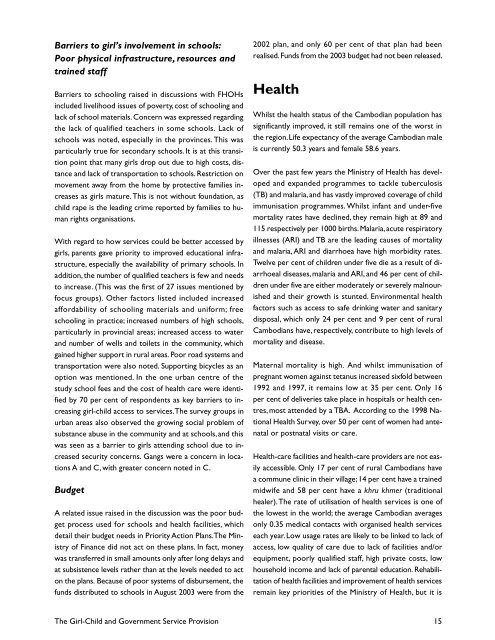The Girl-Child and Government Service Provision.pdf - Tanzania ...
The Girl-Child and Government Service Provision.pdf - Tanzania ...
The Girl-Child and Government Service Provision.pdf - Tanzania ...
- No tags were found...
You also want an ePaper? Increase the reach of your titles
YUMPU automatically turns print PDFs into web optimized ePapers that Google loves.
Barriers to girl’s involvement in schools:Poor physical infrastructure, resources <strong>and</strong>trained staffBarriers to schooling raised in discussions with FHOHsincluded livelihood issues of poverty, cost of schooling <strong>and</strong>lack of school materials. Concern was expressed regardingthe lack of qualified teachers in some schools. Lack ofschools was noted, especially in the provinces. This wasparticularly true for secondary schools. It is at this transitionpoint that many girls drop out due to high costs, distance<strong>and</strong> lack of transportation to schools. Restriction onmovement away from the home by protective families increasesas girls mature. This is not without foundation, aschild rape is the leading crime reported by families to humanrights organisations.With regard to how services could be better accessed bygirls, parents gave priority to improved educational infrastructure,especially the availability of primary schools. Inaddition, the number of qualified teachers is few <strong>and</strong> needsto increase. (This was the first of 27 issues mentioned byfocus groups). Other factors listed included increasedaffordability of schooling materials <strong>and</strong> uniform; freeschooling in practice; increased numbers of high schools,particularly in provincial areas; increased access to water<strong>and</strong> number of wells <strong>and</strong> toilets in the community, whichgained higher support in rural areas. Poor road systems <strong>and</strong>transportation were also noted. Supporting bicycles as anoption was mentioned. In the one urban centre of thestudy school fees <strong>and</strong> the cost of health care were identifiedby 70 per cent of respondents as key barriers to increasinggirl-child access to services. <strong>The</strong> survey groups inurban areas also observed the growing social problem ofsubstance abuse in the community <strong>and</strong> at schools, <strong>and</strong> thiswas seen as a barrier to girls attending school due to increasedsecurity concerns. Gangs were a concern in locationsA <strong>and</strong> C, with greater concern noted in C.BudgetA related issue raised in the discussion was the poor budgetprocess used for schools <strong>and</strong> health facilities, whichdetail their budget needs in Priority Action Plans. <strong>The</strong> Ministryof Finance did not act on these plans. In fact, moneywas transferred in small amounts only after long delays <strong>and</strong>at subsistence levels rather than at the levels needed to acton the plans. Because of poor systems of disbursement, thefunds distributed to schools in August 2003 were from the2002 plan, <strong>and</strong> only 60 per cent of that plan had beenrealised. Funds from the 2003 budget had not been released.HealthWhilst the health status of the Cambodian population hassignificantly improved, it still remains one of the worst inthe region. Life expectancy of the average Cambodian maleis currently 50.3 years <strong>and</strong> female 58.6 years.Over the past few years the Ministry of Health has developed<strong>and</strong> exp<strong>and</strong>ed programmes to tackle tuberculosis(TB) <strong>and</strong> malaria, <strong>and</strong> has vastly improved coverage of childimmunisation programmes. Whilst infant <strong>and</strong> under-fivemortality rates have declined, they remain high at 89 <strong>and</strong>115 respectively per 1000 births. Malaria, acute respiratoryillnesses (ARI) <strong>and</strong> TB are the leading causes of mortality<strong>and</strong> malaria, ARI <strong>and</strong> diarrhoea have high morbidity rates.Twelve per cent of children under five die as a result of diarrhoealdiseases, malaria <strong>and</strong> ARI, <strong>and</strong> 46 per cent of childrenunder five are either moderately or severely malnourished<strong>and</strong> their growth is stunted. Environmental healthfactors such as access to safe drinking water <strong>and</strong> sanitarydisposal, which only 24 per cent <strong>and</strong> 9 per cent of ruralCambodians have, respectively, contribute to high levels ofmortality <strong>and</strong> disease.Maternal mortality is high. And whilst immunisation ofpregnant women against tetanus increased sixfold between1992 <strong>and</strong> 1997, it remains low at 35 per cent. Only 16per cent of deliveries take place in hospitals or health centres,most attended by a TBA. According to the 1998 NationalHealth Survey, over 50 per cent of women had antenatalor postnatal visits or care.Health-care facilities <strong>and</strong> health-care providers are not easilyaccessible. Only 17 per cent of rural Cambodians havea commune clinic in their village; 14 per cent have a trainedmidwife <strong>and</strong> 58 per cent have a khru khmer (traditionalhealer). <strong>The</strong> rate of utilisation of health services is one ofthe lowest in the world; the average Cambodian averagesonly 0.35 medical contacts with organised health serviceseach year. Low usage rates are likely to be linked to lack ofaccess, low quality of care due to lack of facilities <strong>and</strong>/orequipment, poorly qualified staff, high private costs, lowhousehold income <strong>and</strong> lack of parental education. Rehabilitationof health facilities <strong>and</strong> improvement of health servicesremain key priorities of the Ministry of Health, but it is<strong>The</strong> <strong>Girl</strong>-<strong>Child</strong> <strong>and</strong> <strong>Government</strong> <strong>Service</strong> <strong>Provision</strong> 15
















